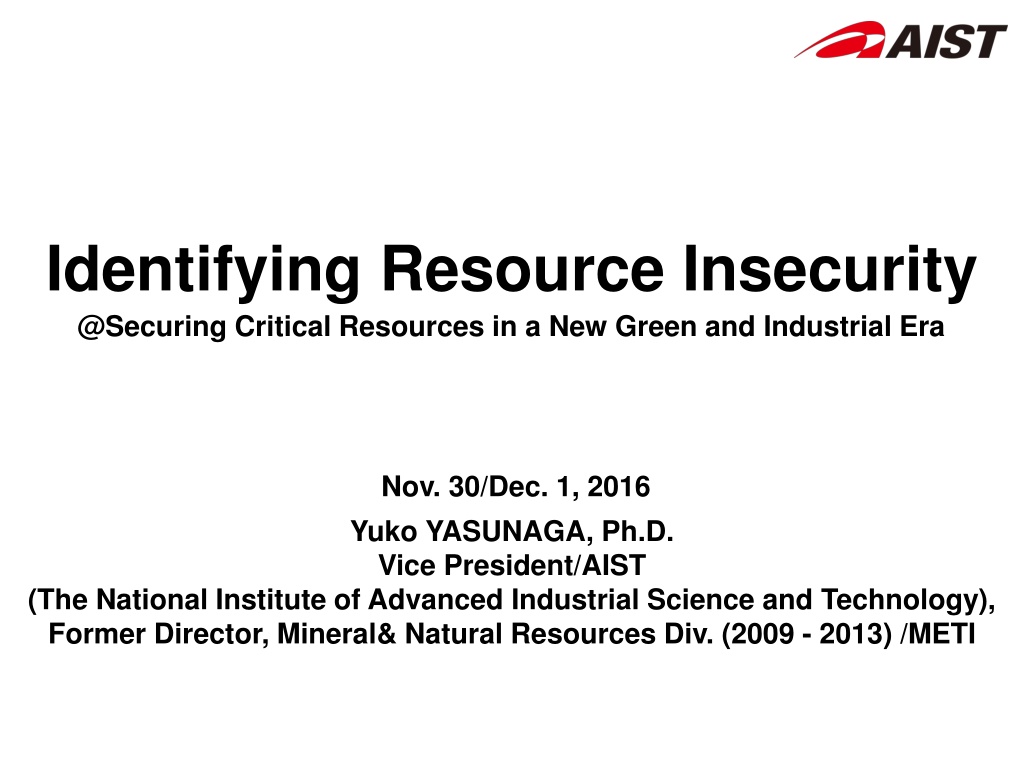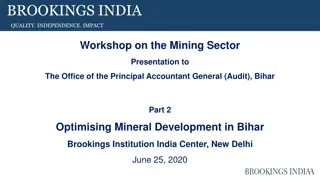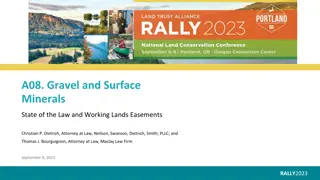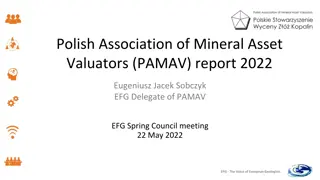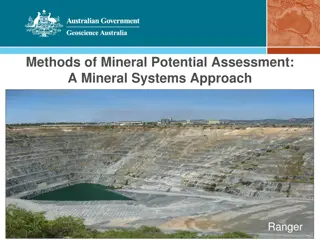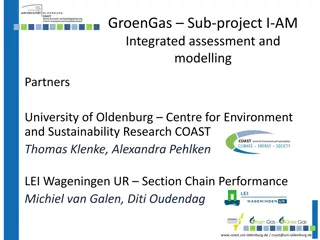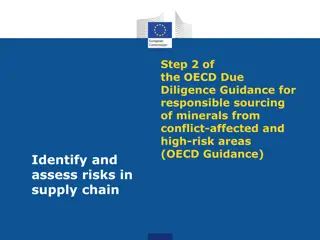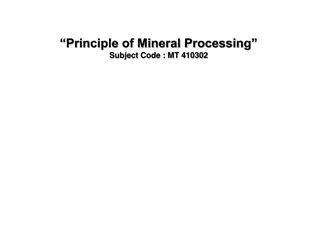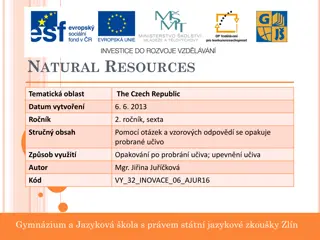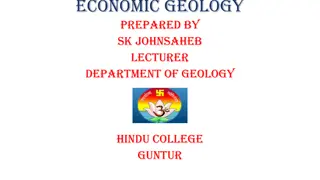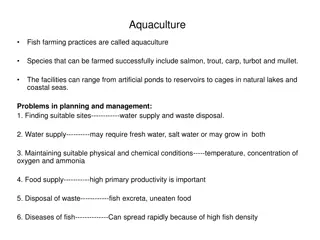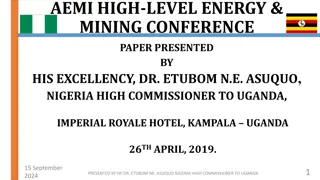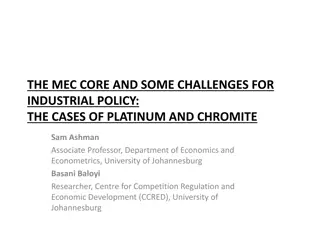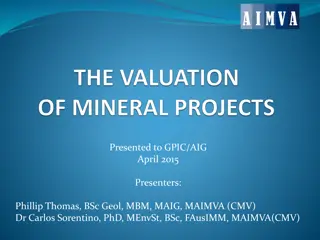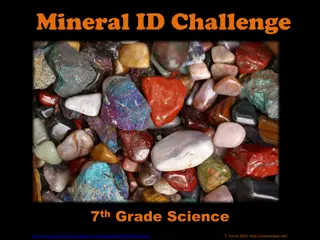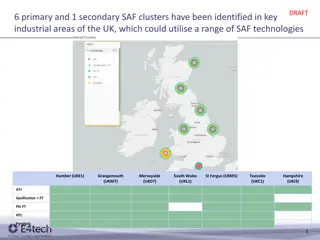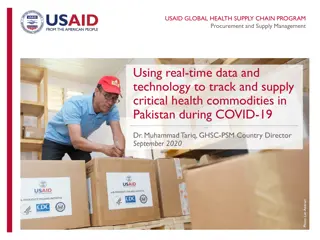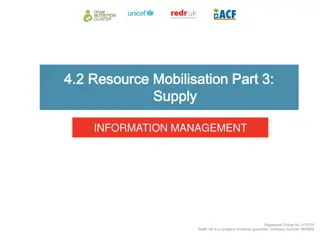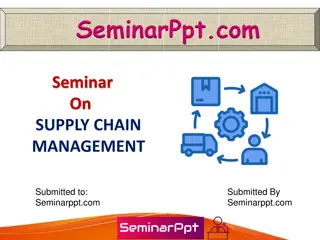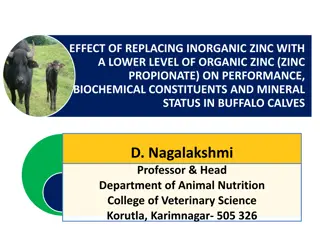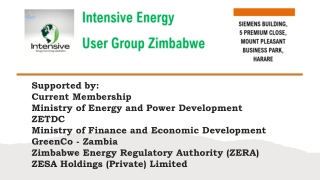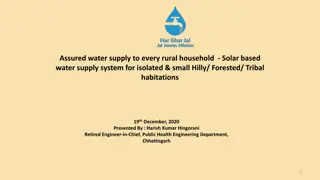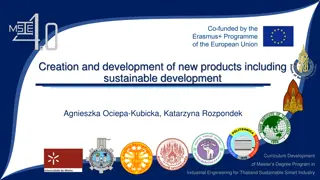Challenges in Ensuring Critical Mineral Supply for Japan's Sustainable Industrial Activities
Japan faces challenges in securing critical minerals for sustainable industrial activities due to market failures in rare metals trade, lack of information symmetry in supply chains, and the small market size of rare metals. The Government of Japan implements policy measures such as overseas resource development and recycling, while industries depict the crucial role of minerals in industrial production. Trade of resources affects overall market understanding, especially in rare metals, which can be oligopolized by a small number of producers.
Download Presentation

Please find below an Image/Link to download the presentation.
The content on the website is provided AS IS for your information and personal use only. It may not be sold, licensed, or shared on other websites without obtaining consent from the author. Download presentation by click this link. If you encounter any issues during the download, it is possible that the publisher has removed the file from their server.
E N D
Presentation Transcript
Identifying Resource Insecurity @Securing Critical Resources in a New Green and Industrial Era Nov. 30/Dec. 1, 2016 Yuko YASUNAGA, Ph.D. Vice President/AIST (The National Institute of Advanced Industrial Science and Technology), Former Director, Mineral& Natural Resources Div. (2009 - 2013) /METI
(Q1) What are the challenges for Japans perspective (government and companies) for ensuring supply? From GOJ (Government of Japan) s Perspective GOJ is responsible for securing supply of minerals which is critical for sustainable industrial activities and people s daily life. Government only intervenes in case of market failure. Market failures are often observed in rare metals trade. GOJ s four policy measures to secure critical minerals : Overseas Resources Development (by financial support to cover political risk) Recycling (w/ reasonable economic conditions) R&D of Substitute Materials Technology Stockpile (released only in emergency disruption of supply) Yuko YASUNAGA 2
(Q1) What are the challenges for Japans perspective (government and companies) for ensuring supply? From Industries Perspective Metals/minerals are indispensable for continuing industrial production. If supply of one mineral/metal/component/sub-system stops, whole supply-chain will stop. Especially for rare metals, imperfect information and information asymmetry hinder designing appropriate redundancy of supply-chain. Yuko YASUNAGA 3
(Q2) How are resources traded and how does that affect overall market understanding of supply? Examples of supply-chain ( cascade ) of rare metals and their downstream products are as follows : Final products Refined (Purified) Materials Minerals Components Devices Sub-systems Ce-carbonate Platinum-metal Zr-oxide exhaust gas purifying catalyst Rare Earths Ore (Ce) Platinum Ore (Pt) Zirconium Ore (Zr) catalyst converter automobile Refined REE (oxide) LCD panel flat panel TV/PC Rare Earths Ore (Y, Tb, Eu) phosphor RE magnet alloys Rare Earths Ore (Dy, Nd, Sm) REE magnet Dy/Nd/Sm-metal motor automobile Total picture of such long and cascaded supply-chain cannot be easily seen from each player. Yuko YASUNAGA 4
(Q2) How are resources traded and how does that affect overall market understanding of supply? Market size of rare metals is far smaller compared to base metals (Fe/Al/Cu/Pb/Zr). >> Mining business of rare metals is NOT, generally speaking, fascinating activities for traditional resources companies, and easily tends to be oligopolized by small number of small producers. Many kinds of rare metals are produced in forms of by-products/co-products of other metal resources. (i.e. Cu/Se+Te+Mo, Zu/In+Ga, Pb/Bi, W Sn, Ni/Co, PGM (Pt, Rh, Rd, Ru, Os, Ir) ) >> Production of by-pro/co-pro type metals cannot be controlled by their own demand, rather affected by other metals' demand (main-product metals). 8 Yuko YASUNAGA
(Q3) What I have learned in 2009-2013 as a Director of Mineral/Natural Natural Resources Div., METI : Rise of new(21stCentury-type) Resource Nationalism. Many people recalled the past experience of resource nationalism in early 1970s. From market point of view, price of rare earth minerals once hiked, and then, went down, as other suppliers began production, demand shrunk due to substitute technologies and recycling, and Chinese producers rushed to sell their excess stocks facing with shortage of cash. That phenomenon itself resembles to the past cases in appearance. However, resource-rich countries rationale to conduct Resource Nationalistic policy has been rather changed (in a sense, further sophisticated,) compared to early 1970s. In early 1970s, resource-rich countries just wanted to control resource production, or just wanted to get more revenue from resource production/export. However, in 2000s, resource-rich countries require down-stream industries to add value to minerals, by choking resource export (as a form of raw materials). In that sense, resource insecurity cannot only be determined from scarcity of such minerals, but also from possibility to manufacture higher-value added products or simply technology to use such minerals. I call this 21stCentury-type Resource Nationalism. Yuko YASUNAGA 6
Supplementary slides for reference 7
Financial Support to Mining Project by JOGMEC (JOGMEC : Japan Oil, Gas and Metals National Corporation) Exploration Equity Exploration Loan Loan Guarantee Asset Acquisition Palmer (Zn,Cu) (2014~) Choiseul East (Ni, Co) (2007~) St. Isabel East (Ni, Co) (2007~) Endako (Mo) (2011) Gibraltar (Cu, Mo) (2009, 2011) Solomon (Ni, Co) (2009) Hishikari(Au Ag) (1981~) Salton Sea(Li) (2011) Los Gatos(Zn Pb Ag) (2014) Tayan(Al) (2011) Oraroz (Li) (2012) Namosi Cu,Au (2010~) Quechua(Cu) (2007~) Low Quality Copper mine (Cu,Au) (2009) Sierra Gorda(Cu) (2011) Mt. Weld(REE) (2010) Esperanza (Cu) (2009) Platreef(PGM) (2011) Australia(Fe) (2012) Rare Metal, REE Caserones(Cu, Mo) (2006~2010) Southdown(Fe) (2008~) Araxa (Nb) (2010) (2011) (2010) Yuko YASUNAGA 3
Example of Metal Recycling Vibration motors: Re Cameras: Ni Au LCD screens: In Integrated circuits: Au Ceramic capacitors: Pd Ni Nickel hydride batteries: Ni Headphone jacks: Au Gold Silver Copper 10.1~12.8g Palladium 0.003~0.005g 0.02~0.03g 0.1~0.13g \ Challenges Collecting large amount of used products efficiently. Development further extracting technology.+ Build up Social System for Recycling with the economy Recyclable Design Yuko YASUNAGA 4
Example of Mineral Resources Used in Our Daily Life: Car * : Elements used in a car Catalyst for exhaust gas Platinum (Pt), Palladium (Pd), Aluminum (Al), Zirconium (Zr), Cerium (Ce) LCD Indium (In) Wire harness Copper (Cu), Beryllium (Be) Battery Lithium (Li), Cobalt (Co) Nickel (Ni), Cerium (Ce) Lead (Pb), Tin (Sn) LED Gallium (Ga) Manufacturing process Drive motor, electric power steering Neodymium (Nd), Dysprosium (Dy), Copper (Cu) Body/Steel components Iron (Fe), Zinc (Zn), Nickel (Ni), Chromium (Cr), Niobium (Nb), Titanium (Ti), Molybdenum (Mo), Manganese (Mn), Vanadium (V) Yuko YASUNAGA Carbide tool Tungsten (W) Cobalt (Co) Motor in a machine tool Neodymium (Nd), Dysprosium (Dy) 6
Supplementary Slides for Reference 11
Rare Earth Elements and Their Applications catalyst optical glass, lithium ion battery, exhaust gas catalyst glass abrasive, exhaust gas catalyst, UV-cut glass magnet, ceramic tile color former magnet, ceramic capacitor Sc La Ce Pr Nd Light no stable radio isotopes Pm Sm Medium magnet phosphor (red) optical glass, neutron shield, super conductor phosphor (green), optical magnetic disk, magnet Eu Gd Tb D Ho Er Tm Yb Lu magnet laser-related product Heavy crystal glass colorant, optical fiber dopant laser-related product laser-related product, optoelectronic device radiation detector phosphor(red), optical glass, battery electrode Y 9 Yuko YASUNAGA
(Q3) What countries dominate the production of rare metals and what does that mean? To identify resource insecurity, we should think: Supply side (1) resource endowment (= geological potential long-run production capacity) (2) production capacity (3) export capacity (= production domestic consumption) (4) analysis of potential risk (political, logistic robustness, etc.) Demand side (5) criticalness for (domestic) industries (from every aspects of supply-chain) (6) possibility of substitute technology (short/mid/long-term) recycling technology (with economic feasibility) Market structure (7) monopoly? oligopoly? monopsony? oligopsony? Yuko YASUNAGA 14
Comparison of Resource Nationalism (70s/ 21stCentury) Past (1960s 70s) Present (21stCentury) Oil, Copper Rare metals (REE, Li, Ni, Co, W, PGM, ) Target Resource World major oil companies (i.e. Seven Sisters) OPEC s national oil companies Small number of (relatively) small mining companies Government of resource-rich (resource-endowed/producing) countries want to control production and export. Who control? Big copper suppliers (i.e. Kennecott, Anaconda, etc.) CIPEC s national copper mining companies To get MORE revenue from resource production/export By nationalizing major (western) companies >>For copper case, nationalization did not work well, since and were both difficult. maintaining the most appropriate mining technique optimizing production in fluctuated of the market To promote DOWN-STREAM industries, which encompasses sophisticated industrial structure by adding more value to resource as a form of raw materials By controlling inward mining investment or choking export (i.e. Indonesian Mining law, China s Export Control of REE) Extreme case is (1) choking export, (2) admitting lower domestic price to domestic users, and (3) attracting transplants from technology-rich countries. Why? & How? Yuko YASUNAGA 15
